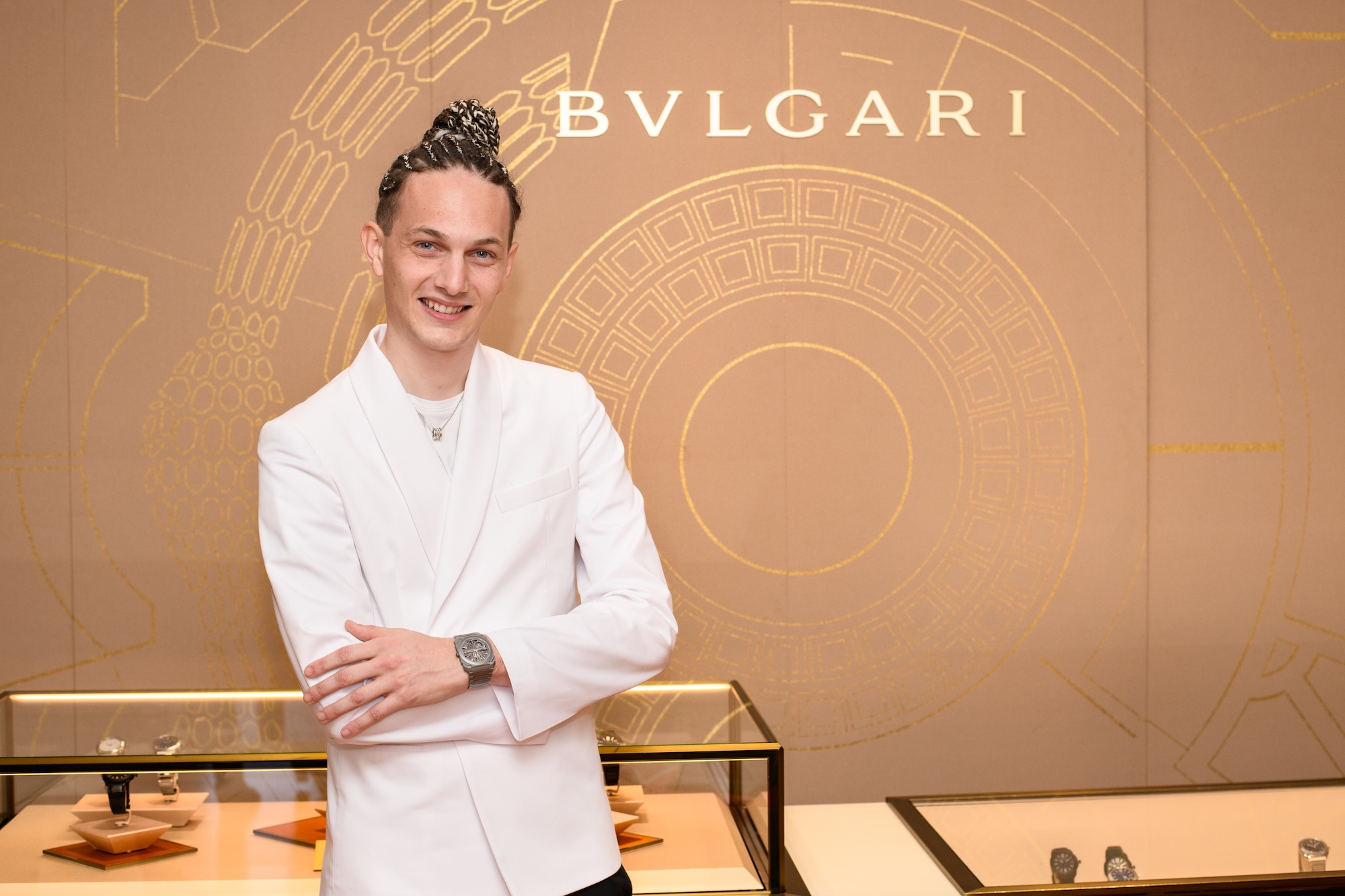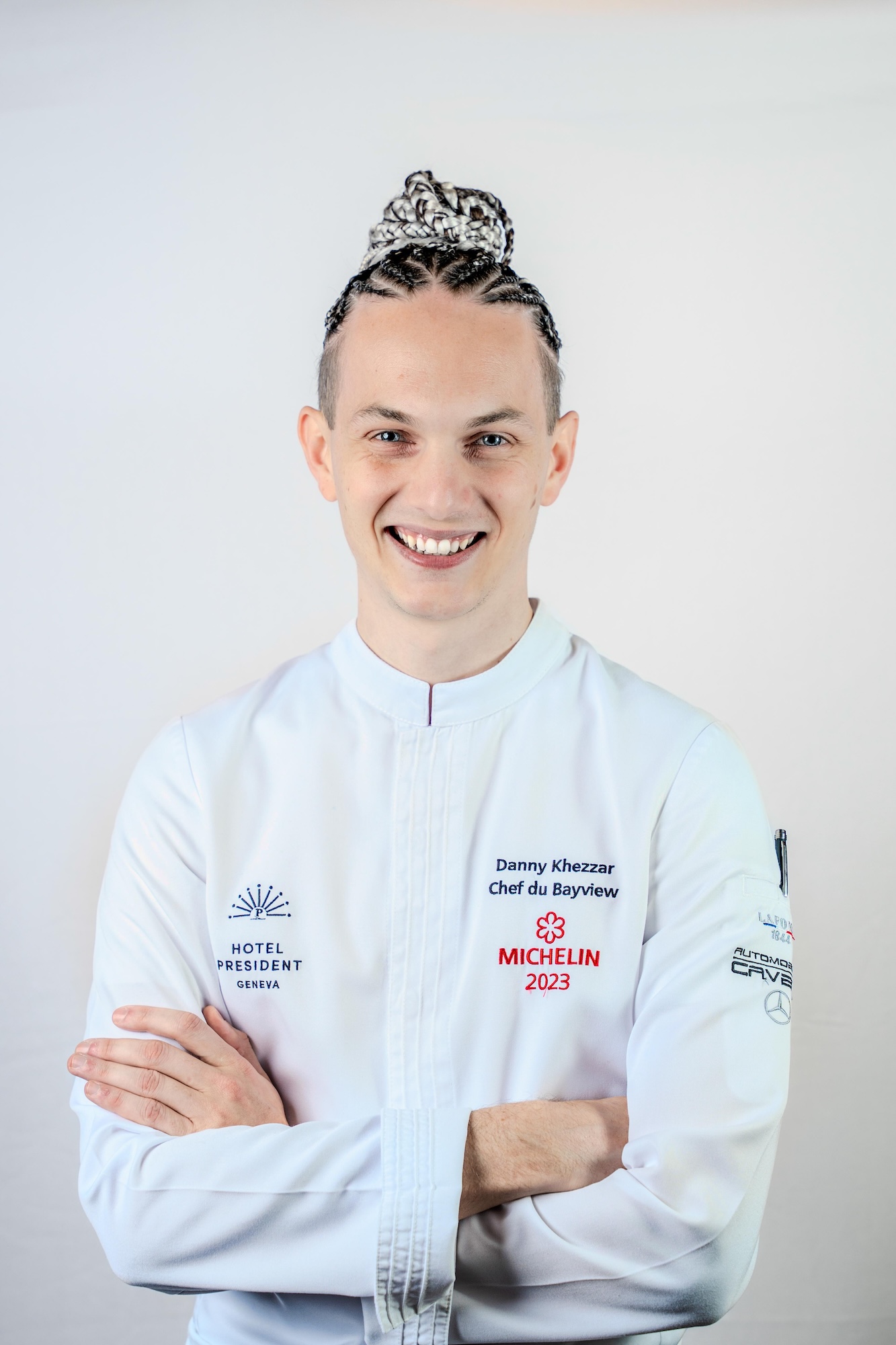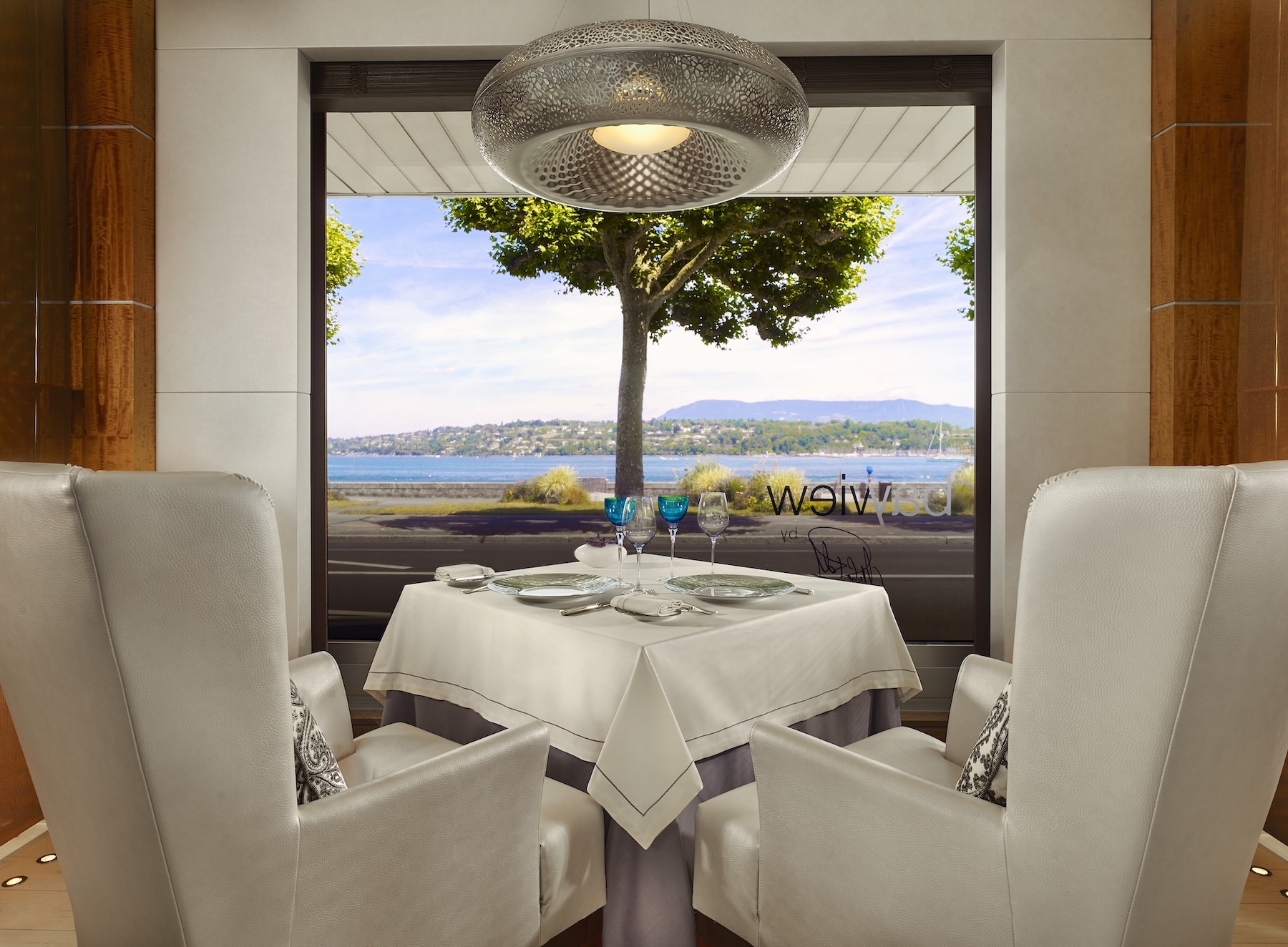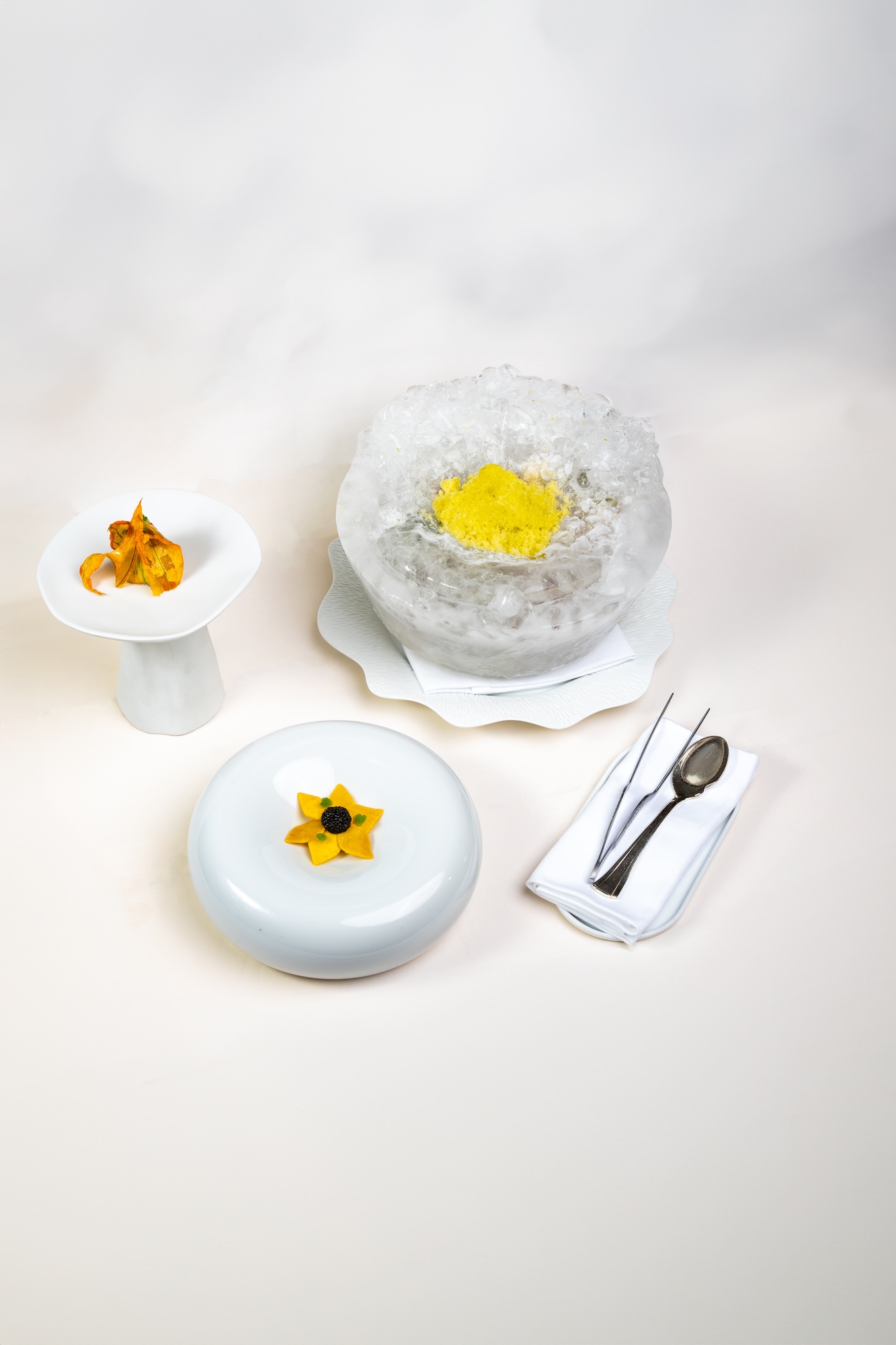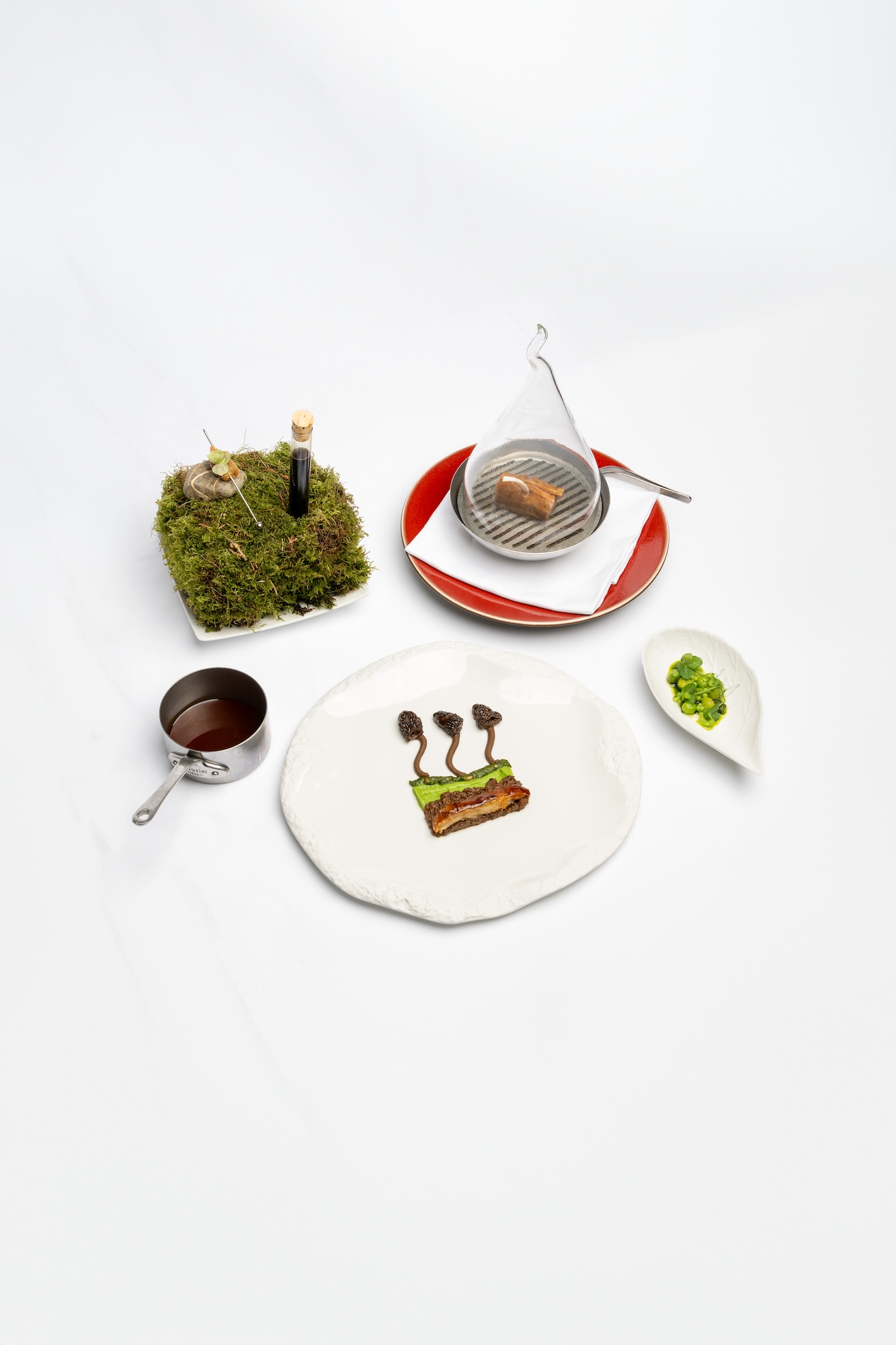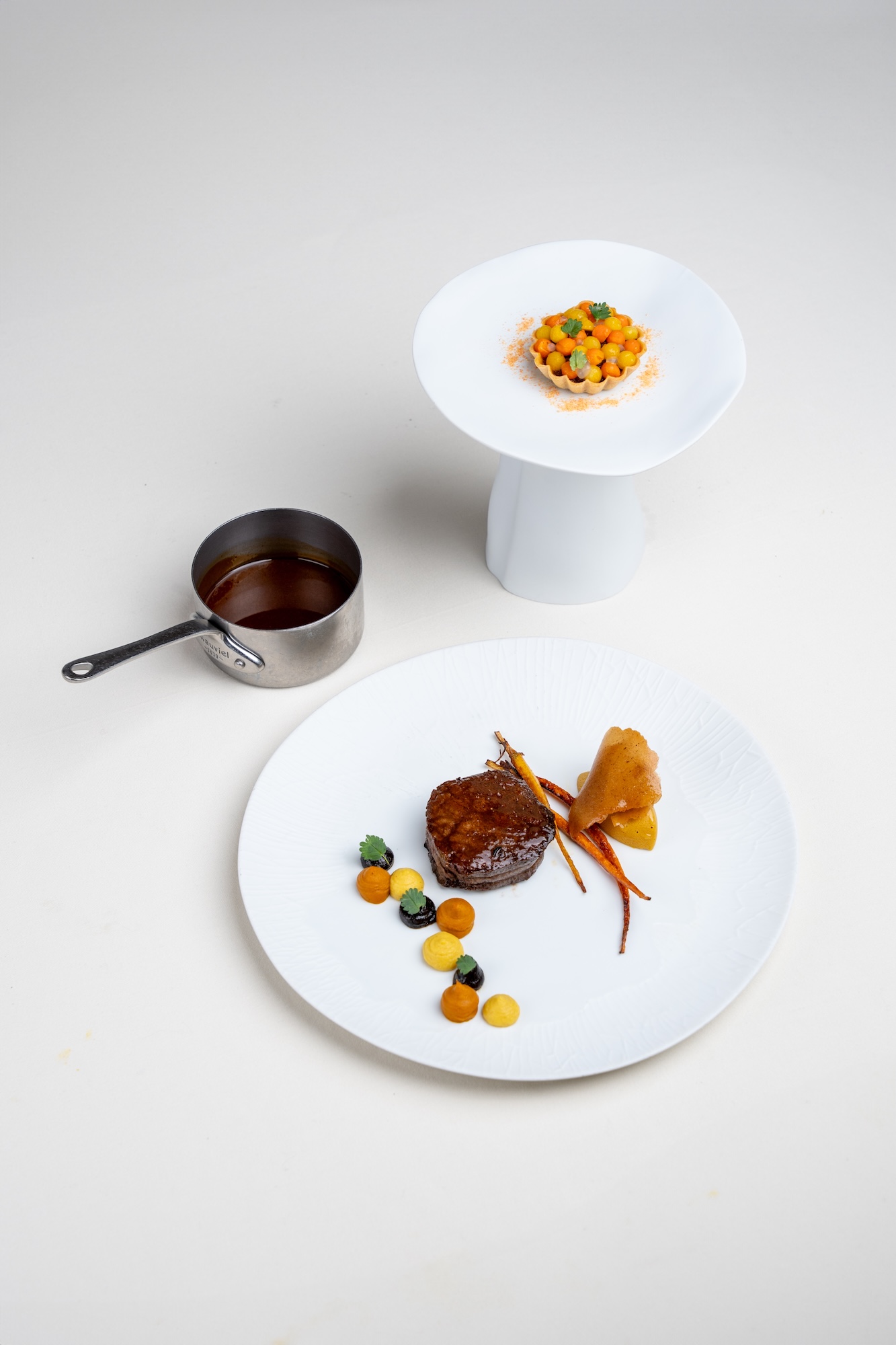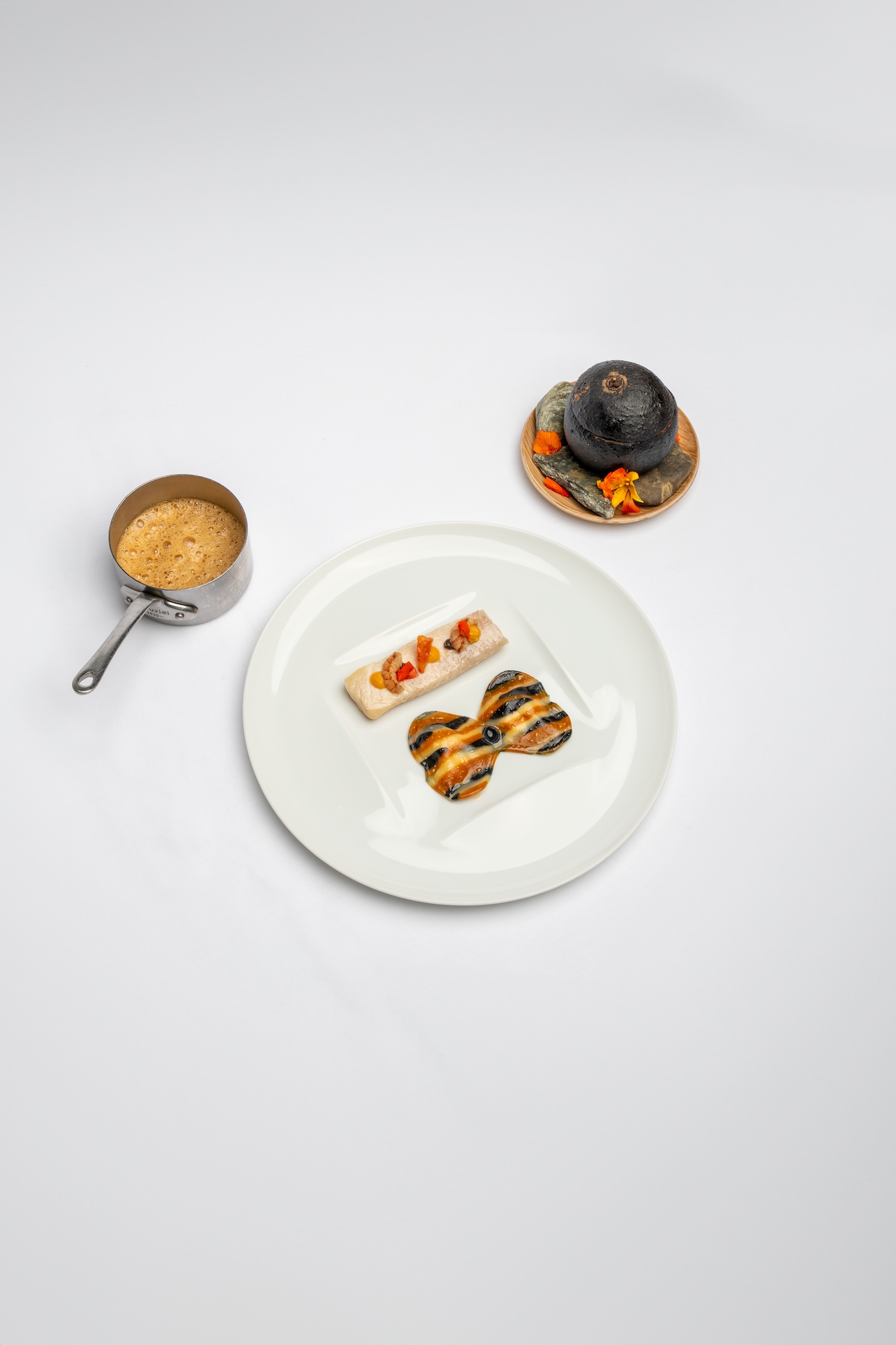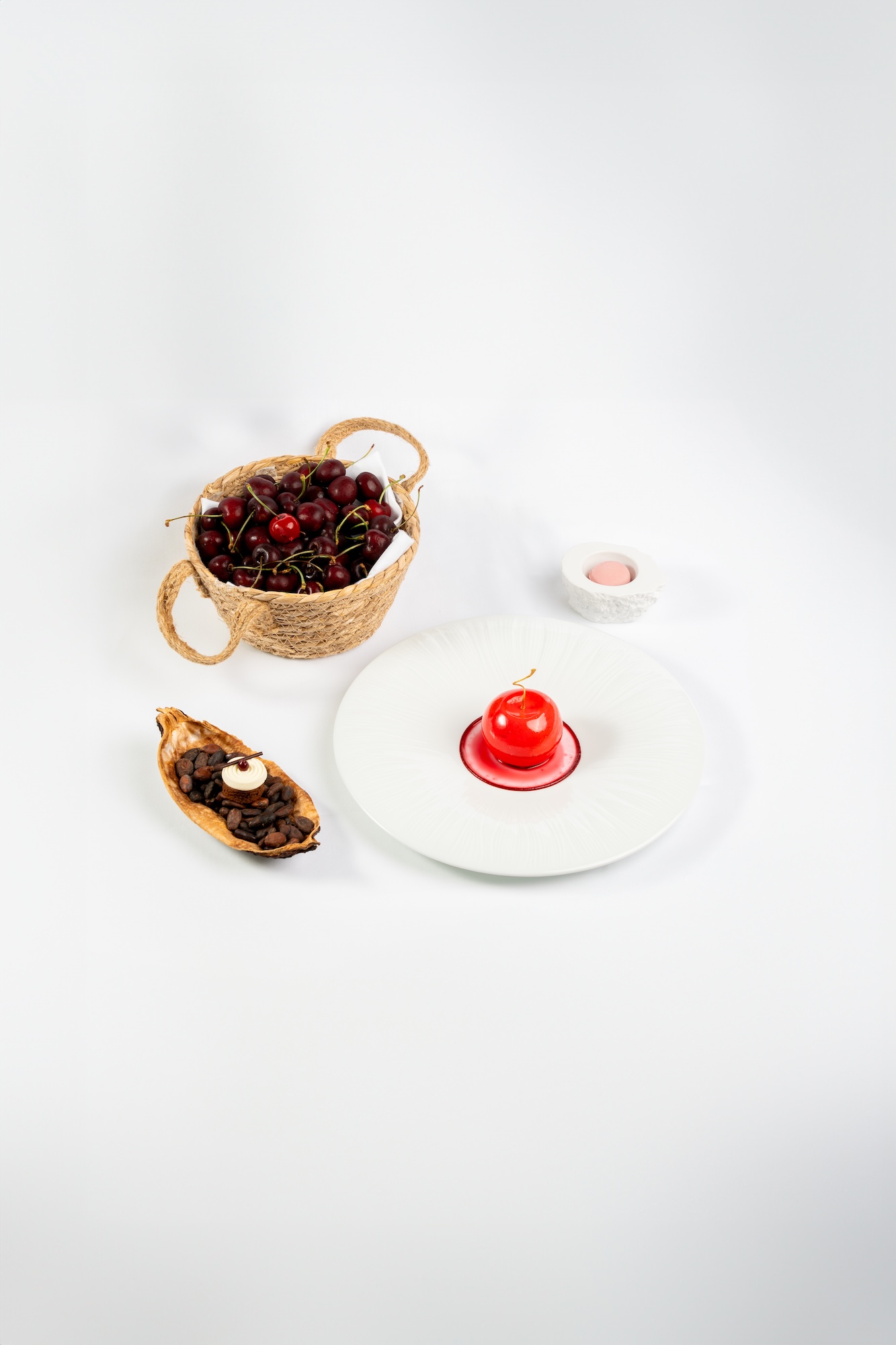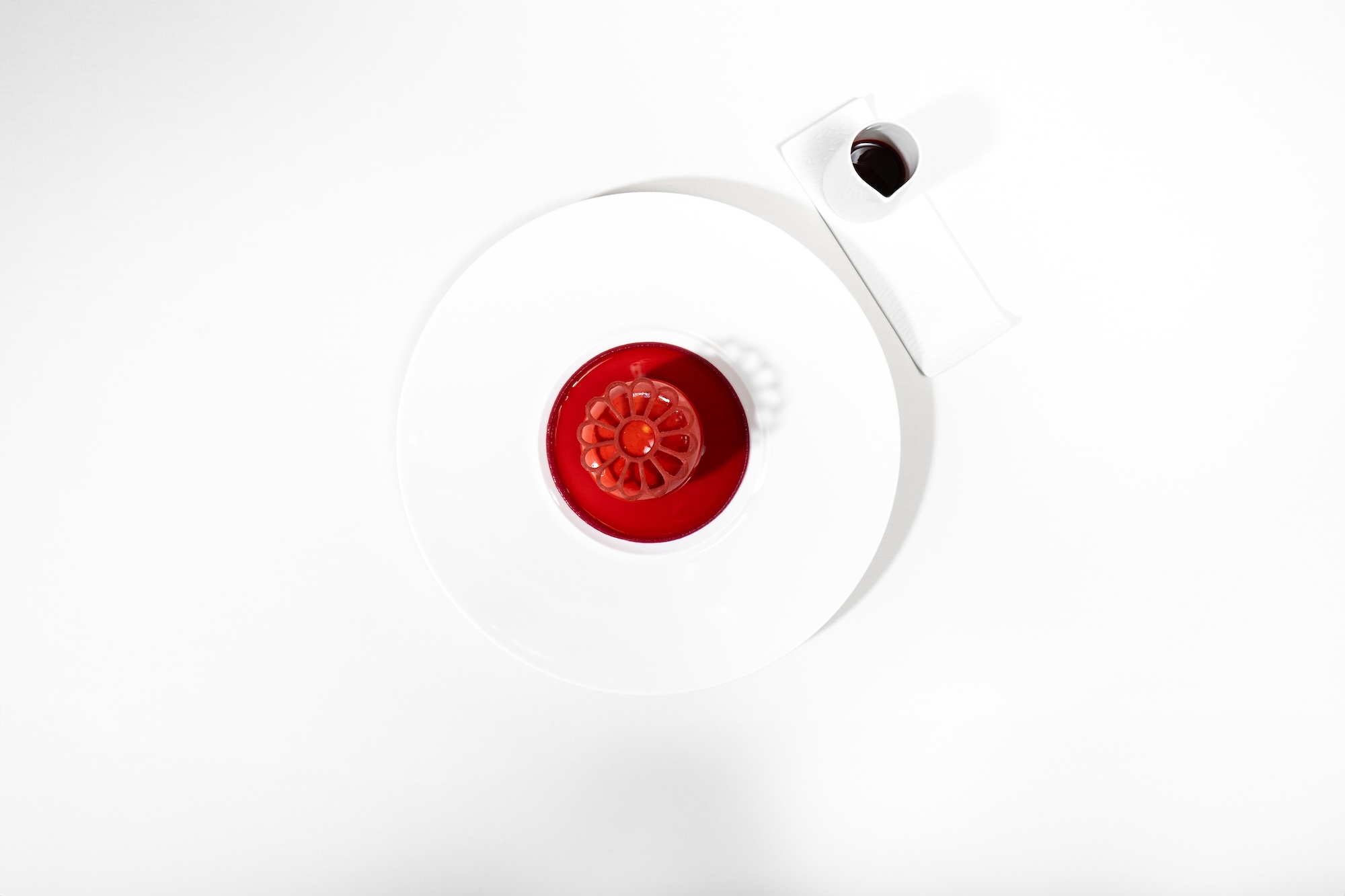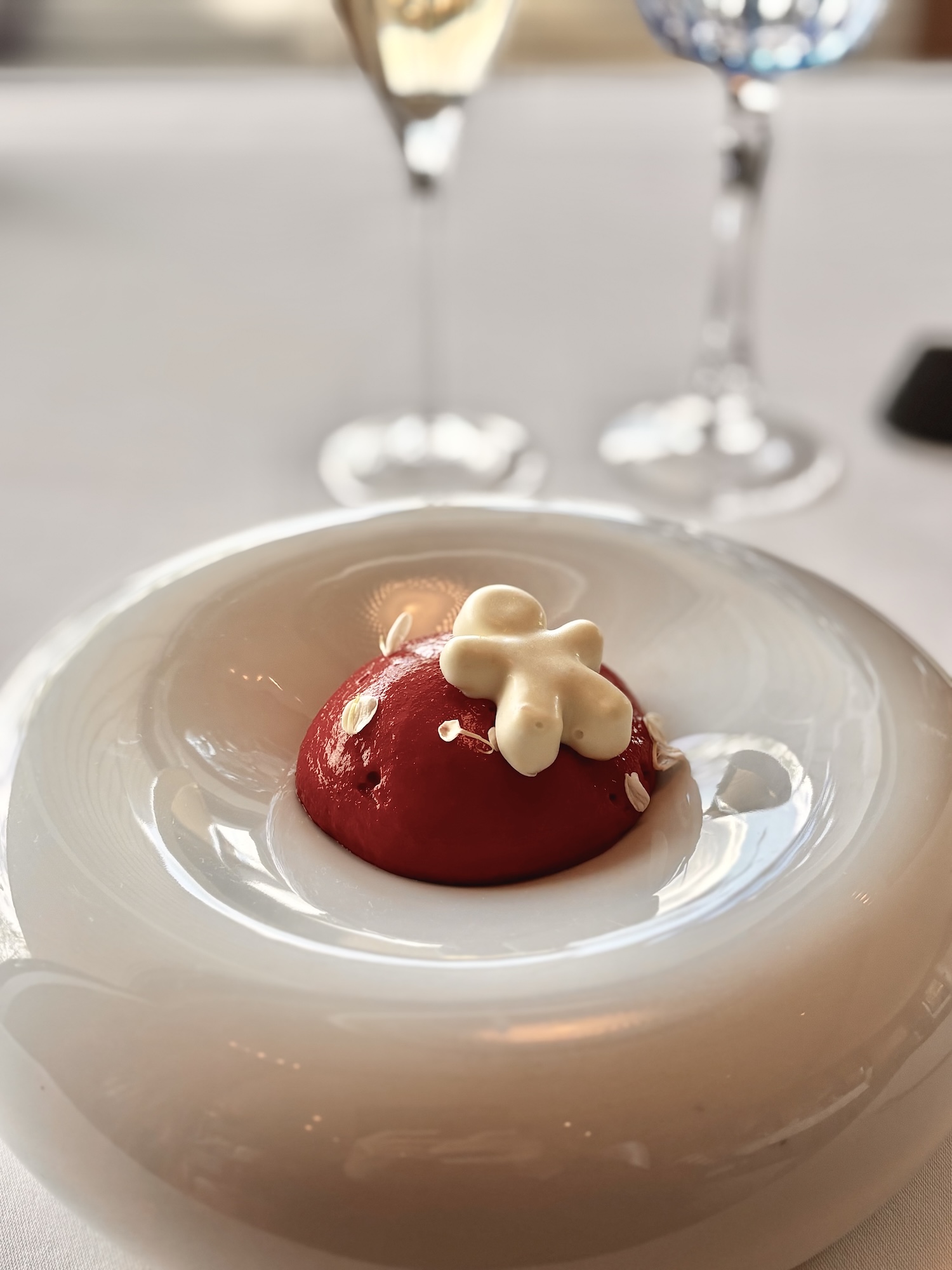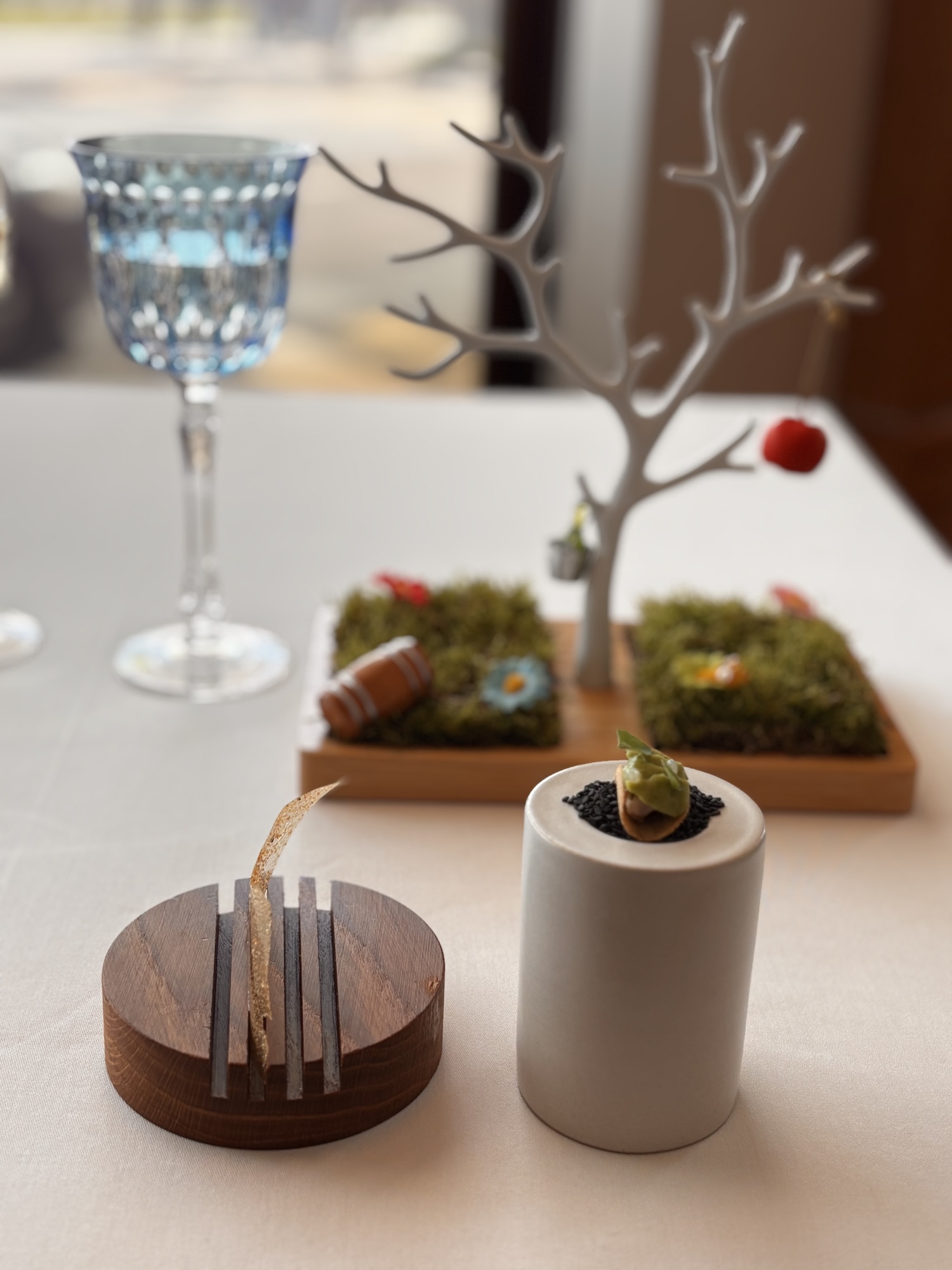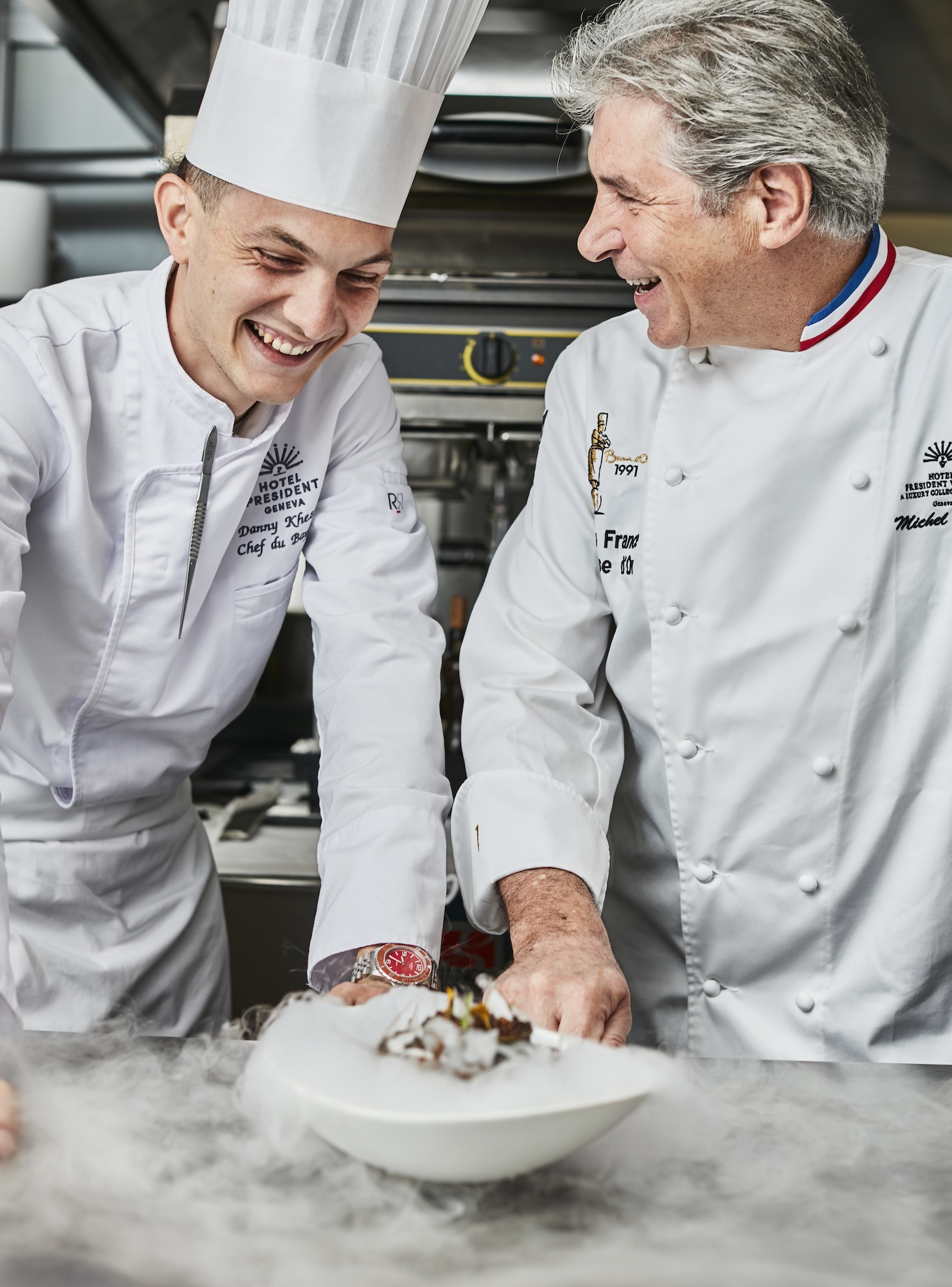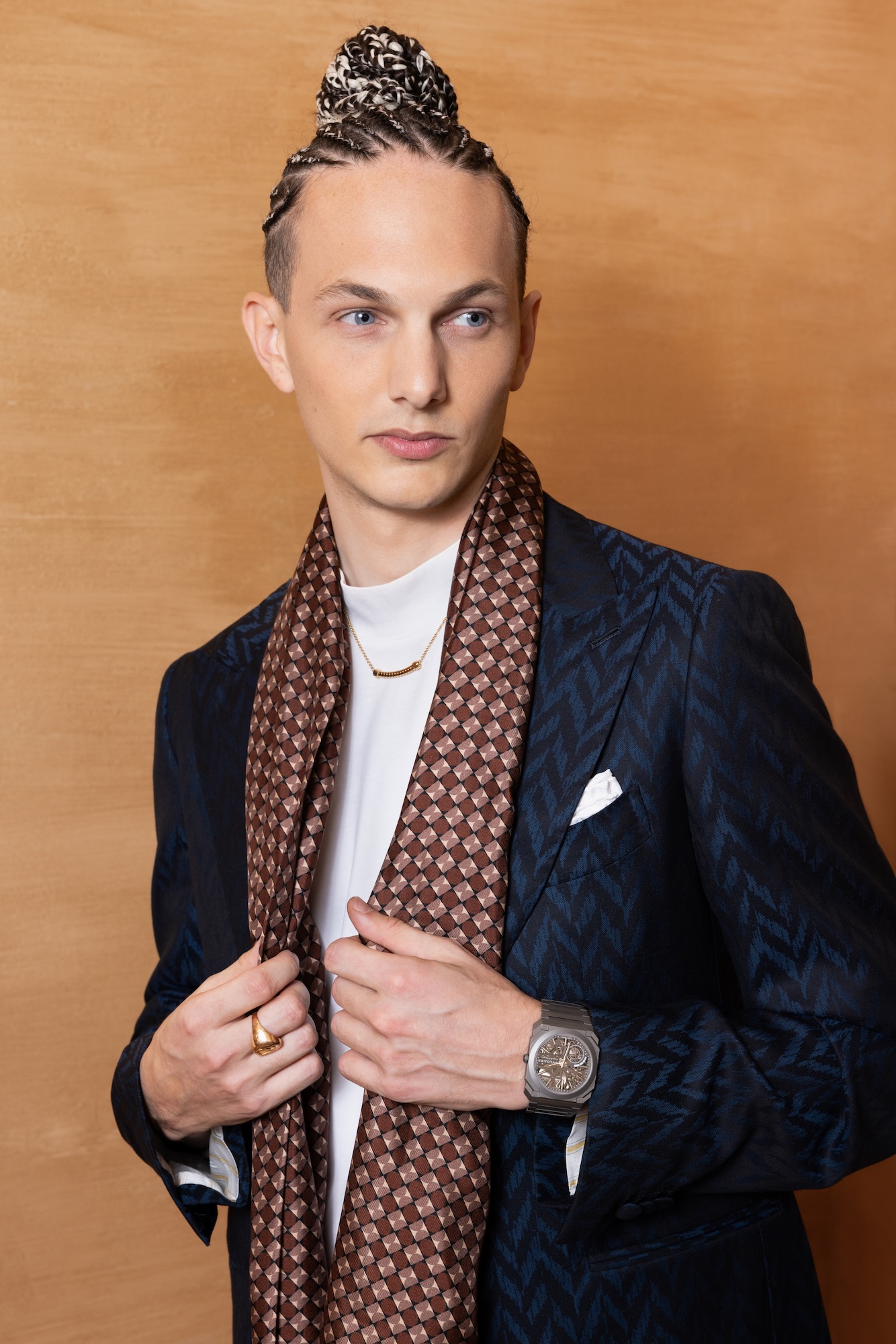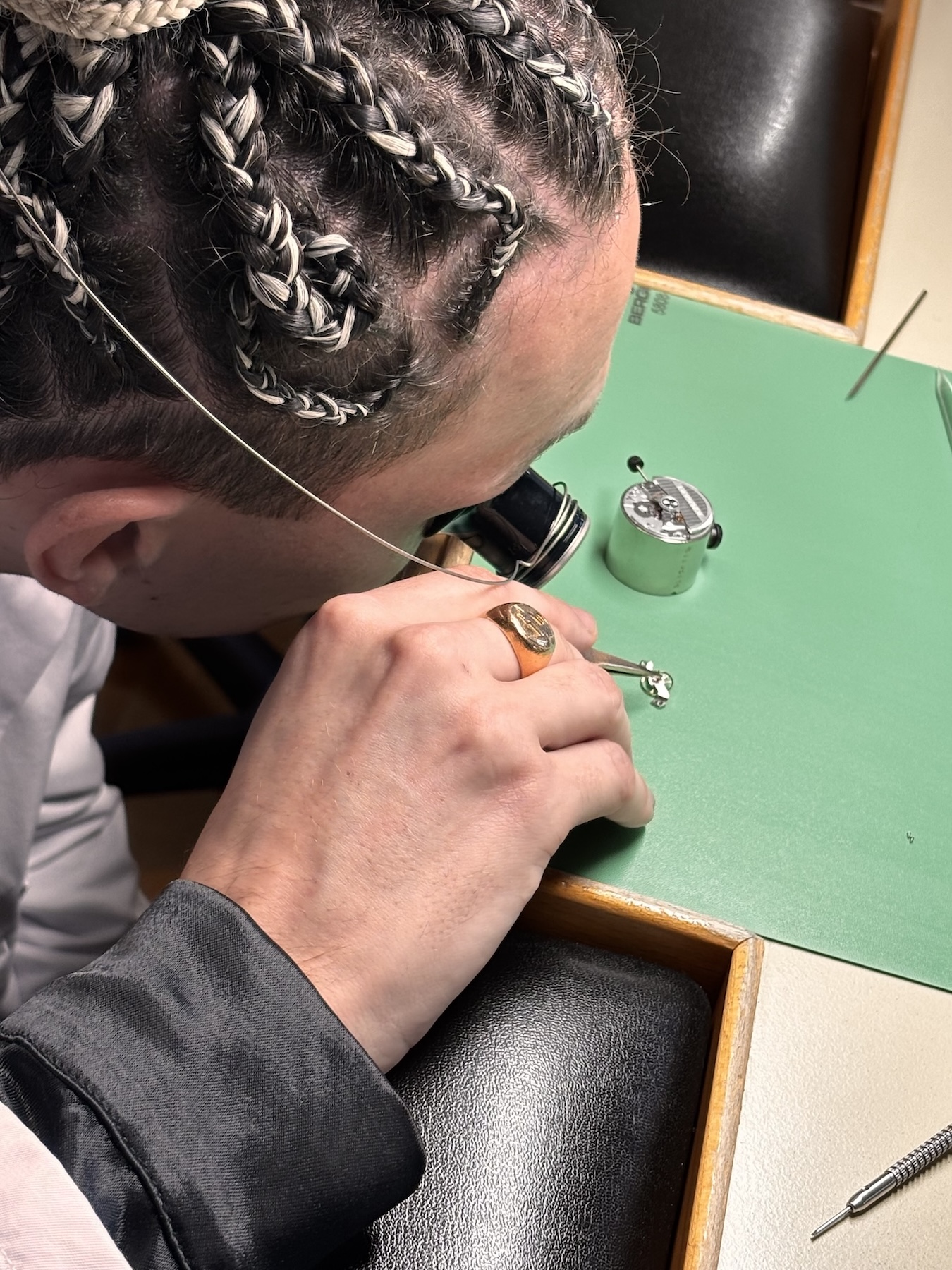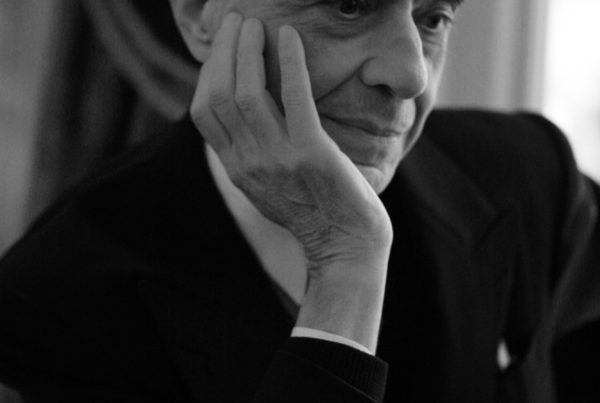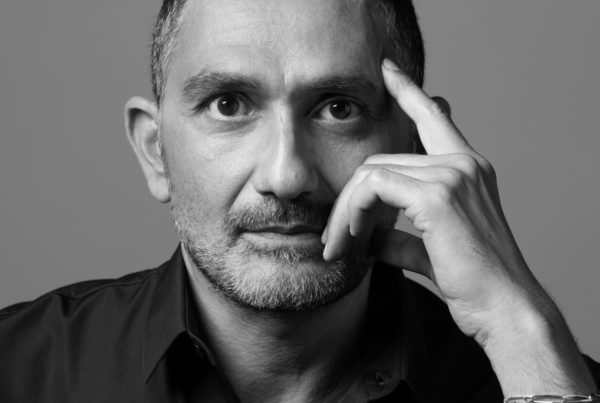‘I wouldn’t want to grow up if growing up meant no longer believing in your dreams’
Chef Danny Khezzar has had a unique career path: he went from growing up in the outskirts of Paris to working at the Ritz, appearing on the TV show TOP CHEF, and then taking over the kitchens at Bayview in Geneva, a Michelin-starred restaurant. He also owns a restaurant in Paris, a bistro called Monsieur Claude, which has just opened in Rueil-Malmaison, and he is about to open a five-star hotel in Courchevel. He is part of a rap group, and his many talents have led him to become one of Bvlgari’s ambassadors for Switzerland. Interview by Isabelle Cerboneschi.
Danny Khezzar, head chef at Bayview, the Michelin-starred restaurant at the President Wilson Hotel in Geneva.
Chef Danny Khezzar’s career path is fascinating because it defies the rules of probability. What were the chances of a 29-year-old man born in the suburbs of Paris becoming the chef of a Michelin-starred restaurant in a luxury hotel in Geneva? While Danny Khezzar owes his passion for cooking to his grandfather, who was a chef, he owes his destiny solely to his own determination.
It takes a lot of courage as a teenager to decide to wear a hoodie over your student uniform at the Jean-Drouant hotel school in the 17th arrondissement without telling your friends back home. And just as much courage to hide his suburban origins from his teachers, ride his bike home at night, sleep for three or four hours, and then head back to Paris to earn his diploma. It takes guts to compete in the TOP CHEF TV show until the final and reveal his double life to all his loved ones. It takes talent to be chosen by Chef Michel Roth and become one of the youngest Michelin-starred chefs at the Bayview President Wilson in Geneva. It takes vision to open two restaurants in Paris. It takes ambition and phenomenal foresight to decide to create a luxury hotel in Courchevel, a project carried out with family and friends. All this without giving up his other passion, music: he writes songs for his rap group Les Frères Bizzy.
President Wilson’s Bayview Restaurant in Geneva, with a view of Lac Léman. Image: Matthew Shaw Photography
Danny Khezzar leads several lives at once. He admits that he sleeps little, ‘four hours a night’. But short nights do not explain his talent. The gifted 29-year-old chef has a way of creating unique dishes. First, there is the appearance. His dishes are as beautiful as miniature works of art to be savoured. He tells us stories that often draw on his memories. He knows how to convey emotion, not with words but with flavours, colours and textures. His dishes move us, sometimes even awakening our own memories.
His cuisine is like a maze, or a puzzle that we try to decipher with every bite: after the emotional phase comes the analytical one. What is this taste: is it really sweet as we think, or is it a trick of the palate? And where does that slight spiciness come from? And that soft texture, difficult to define, somewhere between whipped cream and something else, what is it? The Bayview is one of the only gastronomic restaurants where you can have lunch alone, because you are not alone: you are in good company, with the story that Danny Khezzar has chosen to tell us and that we discover as we go through the dishes.
I met him during a visit to Le Sentier, at the Bvlgari workshops, where he is the watch ambassador for Switzerland. After discovering all the components of the model he was wearing on his wrist, an Octo Finissimo Skeleton 8 Days in titanium, Danny Khezzar sat down at the workbench and discovered how complex it is to polish a tourbillon bridge or install a regulating organ. To each his own expertise…
INTERVIEW
You started cooking at the age of 15: did you always dream of being a chef?
Danny Khezzar: I knew I wanted to be a chef from a very young age. I used to tell my parents that I wanted to be a great chef when I grew up (laughs). I often spent time in the kitchen with my grandfather, who was a cook. He was the one who passed on his passion to me. I loved cooking because it was a time for sharing with my family. Making my loved ones happy was what I enjoyed most.
What did your childhood taste like?
My childhood was a sweet one. Even though I grew up in the Paris suburbs, in Rosny-sous-Bois, in the 93, in Seine-Saint-Denis, I was lucky enough to grow up with my whole family, to have lots of friends, to enjoy my youth, where I was already torn between my love of music and cooking, where I moved between a very strict atmosphere at home and a more urban world outside. It was a beautiful mix.
Your origins are also a beautiful mix.
My father is of Algerian origin and my mother is Italian: my life is made up of mixtures. That’s what shaped me and gave me an atypical character too.
Did this dual heritage influence your culinary choices?
It helped me develop a broader palate. My parents loved going to the market and buying local produce, but it was the spices and condiments that really added a unique touch. From time to time, my father would make tajine. These are childhood memories that I revisit through gastronomy. I was curious about everything. My father loved offal and introduced me to it when I was very young. It’s difficult to eat calf’s head, kidneys or tripe when you’re a child.
Is it because you were familiarised with spices at a very young age that you add subtle chilli notes to your cooking?
When used correctly, chillies add a lot of freshness. My cooking is a blend of well-thought-out sweetness, saltiness and those notes of freshness that you can get with bitterness, that spicy side and different condiments. I also love fermentation and use it a lot. It allows you to add complex notes to very simple things.
When you grow up in the suburbs, cooking isn’t necessarily the first career that comes to mind. Did you encounter any resistance from your friends or family?
There was no resistance because for years I hid the fact that I was studying cooking at the Jean-Drouant hotel school from my friends. We had to wear suits to class, but I couldn’t leave my neighbourhood dressed like that, so I would put on a tracksuit over my clothes and take it off when I got to school. It was only when I took part in the TV show TOP CHEF that my friends discovered I was a chef and that I was leading a double life. Everyone knew I was a rapper, but no one knew about this other passion of mine. My friends thought I couldn’t even cook pasta, when in fact I was already a sous-chef in a Michelin-starred restaurant. They were very surprised, but they took it really well: they were extremely proud. The show allowed me to be completely myself.
And how did things go in the kitchen?
I didn’t want the chef to fall into clichés and see me as a suburban kid who raps and has no future in gastronomy, so I hid who I was. When I put on my chef’s hat, there was no sign of the suburbs. It was just very complicated in the evening when we finished around 1 a.m. and there was no public transport to get me home. I went through some very tough times. Sometimes I had to ride my bike home and I would arrive at 2 a.m. I would take a 3- or 4-hour nap and then I had to go back to Paris to be in the kitchen at 7 a.m. It was a complicated life, but I hid it to avoid preconceptions.
When was the turning point when you realised that you were going to make cooking your career?
To celebrate my 15th birthday, my parents treated me to brunch at the Ritz. It was wonderful! Chef Michel Roth was in the restaurant and my father encouraged me to go and introduce myself. He was really nice, he showed us around the kitchens, he gave me his card, and that’s how it all started. I did my internship there, in this Parisian palace with two Michelin stars.
Surprise croquante: burnt vanilla espuma, candied cranberries, a dessert like a work of art, created by Danny Khezzar.
Each of your dishes is a work of art that transports us to an enchanting world: some are like sculptures, others like children’s drawings. Is this a way of telling stories, or perhaps your story, through food rather than words?
When I create, I start with a story I want to tell. I want to offer a part of myself on the plate, and since we are lucky enough to be able to design menus with several courses, we can tell a story. I love that moment of connection, when a dish I have created based on one of my childhood memories also awakens a memory in someone who is tasting it. Without even speaking. That’s the magic of our profession. It’s what drives me to be ever more creative.
In fact, when I tasted your dish Le Saut de l’Ange, I was overcome with emotion: it was associated with a childhood memory of a field of daffodils in Les Pléiades. What memory does this dish refer to?
This dish evokes the day I discovered the mountains and snow. We had gone on a school ski trip and my first impulse was to throw myself into it, in all innocence. I thought it made sense to start a menu this way, inviting people to let go and throw themselves into the snow like children. I find it both poetic and playful. This dish reflects who I am. We worked hard to create this little man in this shape, with this taste and this fairly soft texture.
Le Saut de l’Ange, beetroot bed sprinkled with jasmine petals, creamy pea tofu ©Isabelle Cerboneschi
What is the starting point for a recipe?
My drawings. I sketch my dishes in pencil after choosing the story I want to tell. For example, I want to go with ‘the best of the best’. But what does ‘the best of the best’ mean to me? It could be the parsley sauce on the escargot, for example, or the base of the baked tomato dish with its juices that have stuck to it. I start with this feeling of the best of the best, then I draw whatever comes to mind, and then we start creating.
At the very beginning of the menu, we are served a dish that is like a rural landscape with a miniature tree with what looks like a cherry hanging from it. What would be ‘the best of the best’ in this dish?
It’s the dish that starts the menu, and for me, the beginning is the Garden of Eden, with the red apple hanging from the tree and the grass underneath. Except that instead of making an apple, as we were in the middle of cherry blossom season, I chose a cherry. I worked with sencha tea, which brings a lot of freshness, and sakura leaves in all their forms: in jelly to bring freshness and acidity, and in a light mousse, which could be reminiscent of whipped cream. The coating is made of cocoa butter, which adds a little fat and gives the impression of something sweet, even though there is no sugar in this dish. It is our subconscious that makes us believe it is sweet, with the cocoa butter found in chocolates and the mousse, which is reminiscent of whipped cream. There is also a little fleur de sel.
Gratin Dauphinois-style potato tiles, mini Arctic char tacos, trompe l’oeil cherries with sakura jelly ©Isabelle Cerboneschi
Do you apply the same principles when you create the titles of the songs for the band Les Frères Bizzy?
Yes, but I didn’t realise it straight away. When you create music, you also start with a blank sheet and compose as if you had all the ingredients in front of you, except that they are instruments. You start with a theme, called a topline, and let the melody develop on its own, without adding any words. Only then do we create the lyrics. There’s a real parallel between these two arts. In fact, there are lots of words from music that we find in cooking: we talk about a piano, when we baste meat we say it sings, there’s a rhythm in cooking too.
Your recording studio is located in a garage in Gaillard, a French suburb near Geneva, and your kitchen is at the Président Wilson. That’s quite a leap!
That’s the story of my life: going from a basement in the suburbs to a palace by the lake. I feel comfortable in both worlds. It’s the mix of my life.
Do you believe in magic?
Yes. You have to keep believing in magic, like a child does. You have to hold on to that mindset for as long as possible. I wouldn’t want to grow up if growing up meant no longer believing in your dreams.
What has been the most memorable moment you’ve experienced in the kitchen?
There have been so many highlights! Perhaps cooking alongside three-star chef Hélène Darroze? I never thought that would happen to me, sharing my kitchen with someone of that caliber. There was also the first time I was appointed to the Bayview, the day we received our star. When I was younger, the first time I set foot as a cook at the Ritz, at L’Espadon, which has two Michelin stars. There are so many highlights that mark a career, and it’s not over yet (laughs)!
Which dish evokes the most emotion for you?
I would say gratin dauphinois. I made a classic gratin dauphinois with just a hint of champagne in the sauce to give it freshness and liveliness, and I created a transparent tuile that echoed the taste of the gratin dauphinois on top. This tuile made such an impression on me that I decided to detach it from the dish and turn it into something unique. It has become a signature tuile that people love because it’s surprising.
Indeed, your tuile tastes like gratin dauphinois, yet it looks like a caramel leaf.
It has a kind of magic: it’s transparent, ultra-thin, and at the same time, it’s a very rich, fatty dish that’s round in the mouth. This tuile gave me a lot of emotion because I was very proud to be able to realise the idea I had in my head. I found the taste of my grandmother’s gratin in this little tuile. It was an achievement. The team and I were thrilled. When I told them we were going to make a transparent gratin dauphinois, they looked at me with wide eyes, as if it were impossible (laughs).
Trompe l’oeil cappuccino, Charlotte potato purée and fresh morel mushrooms, breadcrumbs and potato croissant ©Isabelle Cerboneschi
Your potato croissant is another signature creation. Where did it come from?
It made a big impression during the TOP CHEF show and earned me a huge following on social media. It was right in the middle of the trompe-l’oeil trend, but what I don’t like about trompe-l’oeil is that it’s the easy way out, using moulds. But this croissant was created from scratch! We took the idea of puff pastry sheets and replaced them with layers of potato. This croissant has been copied by hundreds of chefs and recreated with other vegetables, which makes me proud because it came from my brain.
Are there copyrights on recipes?
No, and that would be counterproductive because cooking is something that should be shared. You have to be willing to share recipes, otherwise I wouldn’t have been able to make my version of gratin dauphinois: who invented it? You shouldn’t keep your recipes to yourself, on the contrary. We create dishes, we are just passing through, and it would be magical if, in 100 years, someone were to make potato croissants again! You have to let recipes live…
How were you chosen to become the Chef at Bayview?
It happened naturally. I’ve been working here for ten years, and before TOP CHEF, Michel Roth and I had already discussed it a little. He thought that after the show I might leave, and he advised me to stay. I was already creating the menus, but I didn’t have the title of chef. He gave me that title and put me in charge of the restaurant in May 2023.
Chef Danny Khezzar with Chef Michel Roth in the kitchens of Bayview, President Wilson’s Michelin-starred restaurant in Geneva.
How did you feel the first time the team said, ‘Yes, Chef!’?
(Laughs). I don’t want to be called Chef, so the team often calls me Danny. It’s only during service, when I ask them to be rigorous, that the ‘Yes, Chef!’ comes out naturally, but I don’t need that. What interests me is team spirit: making sure everyone is united and that information flows smoothly. I’m like an orchestra conductor.
Are you chasing stars?
Yes, it’s a childhood dream. We’re working towards the second one, and once we’ve got that, we’ll work towards the third. There’s still plenty of room for improvement. We’re very happy with the feedback from our customers and we hope that the guides will follow us and push us to go further.
The Bayview Restaurant, with a view of Lac Léman. Image: Matthew Shaw Photography
You have a huge community on social media: to date, 843k very active followers on Instagram, who comment, get excited, and come to discover your cuisine at the restaurant. How does that make you feel?
It’s great! I went from obscurity to fame very quickly. I’m doing the same job as before, except now more people are seeing it. I receive a lot of positive messages and that makes me want to continue doing this job because without recognition it’s difficult with all the sacrifices it requires.
You were chosen to be one of Bvlgari’s ambassadors for Switzerland. What does that mean to you?
Little Danny, who was born in the suburbs of Paris, would never have imagined that one day he would be the face of a major brand, and it’s an honour. There are parallels between watchmaking and gastronomy: the clientele, the craftsmanship, the hospitality. A day like today, spent visiting the workshops and meeting the artisans behind this great brand, is what I enjoy most. It’s a bit like when I visit our producers: without them, we couldn’t do what we do. We are the last link in the chain. I am very proud to have been chosen by Bvlgari and I think there are many things we could co-create together.
Michelin-starred chef Danny Khezzar, one of Bvlgari’s watch ambassadors for Switzerland, wears an Octo Finissimo Skeleton 8 Days watch in titanium.
Time is an essential element for a watchmaker, but also for a great chef.
Of course. Without timing, you can’t cook. You need a tempo, a rhythm during service. Watches were originally made to tell the time, something very simple, but the big brands have created great complications. Well, gastronomy is a bit like that: basically, it’s for nourishment, and we’ve turned it into something very complex.
Is there a watch in the collection that reminds you of your kitchen?
I really like the one I’m wearing, the Octo Finissimo Skeleton 8 Days in titanium. First of all, there’s the transparency: you can see all the components and how they fit together inside the case, as if someone had arranged all these little pieces on a plate. This type of watch, which reveals all the work done in the workshop, represents me much more than a model with a dial that hides the movement. In fact, at the manufacture, you can see the craftsmen with their little tweezers placing all the elements one by one, a bit like us when we arrange the elements on our plates – with the same tweezers, in fact – and compose a dish.
Danny Khezzar at a workbench in the Bvlgari workshops in Sentier attempts to assemble a regulating organ ©Isabelle Cerboneschi
What dish best describes you, expressing everything you are?
I finally revisited my mother’s veal blanquette, a dish that embodies my entire childhood: it was one of my favourites. I always had more sauce than rice (laughs). I remade it my way and managed to give it my own personality, while retaining that feeling of rice in sauce and shredded meat.
What about your father’s couscous?
I find it hard to choose. There are so many stories behind all these dishes. When I recreated my father’s couscous, it was a challenge: imagine couscous in a gourmet restaurant! I used a Japanese coffee maker and, instead of making coffee in it, we made a tagine broth that we infused in front of the customer, with lemongrass, ginger, oregano, etc. We chose a magnificent little lamb from Appenzell and used harissa, but very mild, and condiments. The dish captured the spirit of couscous, but in a gourmet version. People loved it, and so did I.
What are the limits of creativity in cooking?
I don’t think there are any. The only limits are the ones we set ourselves. Sometimes we have ideas, and we’ll try 80 times to get it right, but we don’t give up. For example, we created an edible balloon that flies, with a taste that’s sealed inside. I haven’t released it yet because it’s not quite ready, but we must have already done a hundred trials. I know we’ll get there.
Would you like this edible balloon to fly around the restaurant?
I want it to be held on a string and for the waiters to walk around the restaurant with it. A great chef did this in Spain, but he never gave away his recipe, so we did something different: his balloon sticks to your lips, whereas ours disappears completely.
Is there a recipe that you haven’t been able to master yet?
But there are so many others! We launch projects and as long as we’re not satisfied with the result, we don’t present it. And since we have new ideas every day…
When you say ‘we,’ do you mean ‘I’?
Yes (and he bursts out laughing).

